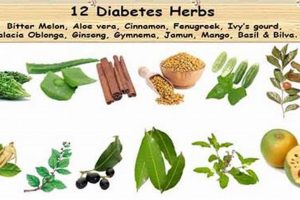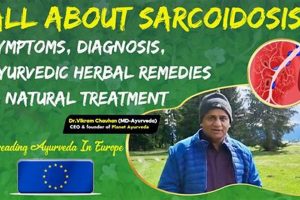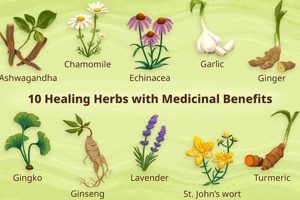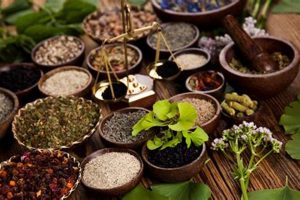The utilization of plants and their extracts to alleviate the symptoms associated with acute respiratory distress episodes is a practice spanning centuries. These natural substances are sometimes considered as complementary or alternative therapeutic approaches, distinct from conventional pharmaceutical interventions, for managing conditions characterized by airway inflammation and constriction.
Throughout history, various cultures have employed botanical preparations to address respiratory ailments. The perceived advantages of these methods often encompass accessibility, reduced cost in certain contexts, and a holistic approach to wellness. However, the efficacy and safety of these treatments necessitate rigorous scientific evaluation to ascertain their validity and potential risks.
The subsequent sections will delve into specific plant-derived options that have been explored for their potential role in mitigating breathing difficulties during acute episodes, alongside a critical examination of their mechanisms of action and available research findings.
Guidance on Plant-Based Approaches During Acute Respiratory Distress
The following guidance provides information regarding the potential use of botanical substances during periods of acute respiratory distress. It is imperative to consult with qualified healthcare professionals before implementing any of these suggestions, as they are not intended to replace conventional medical care.
Tip 1: Research Potential Interactions. Prior to use, thoroughly investigate possible interactions between herbal substances and any prescribed medications. Consult pharmacists or medical professionals to ensure compatibility and avoid adverse effects.
Tip 2: Verify Source and Quality. Obtain plant-derived products from reputable sources to ensure purity and standardization. Look for products with third-party certification to confirm the absence of contaminants and accurate labeling of active ingredients.
Tip 3: Monitor Respiratory Function. Closely observe breathing patterns and oxygen saturation levels when using plant-based interventions. Utilize pulse oximetry if available, and promptly seek emergency medical attention if respiratory function deteriorates.
Tip 4: Avoid Known Allergens. Exercise caution when using botanicals if known allergies exist to related plant families. Perform a small skin patch test to assess for potential allergic reactions before widespread application or ingestion.
Tip 5: Consider Anti-Inflammatory Properties. Explore botanical compounds with established anti-inflammatory properties, such as those found in certain teas or extracts. Reduction of airway inflammation may assist in easing breathing difficulties.
Tip 6: Maintain Hydration. Adequate fluid intake helps to thin mucus secretions, potentially facilitating easier expectoration and improving airflow. Water is generally the preferred choice; avoid sugary or caffeinated beverages.
Tip 7: Implement Alongside Prescribed Therapies. If a decision is made to integrate plant-based substances, do so in conjunction with, rather than as a replacement for, prescribed inhalers or other medical treatments. Regular communication with healthcare providers is essential.
These suggestions highlight important considerations regarding the use of plant-derived options during periods of respiratory distress. While some botanical compounds may offer complementary support, they should never supersede established medical protocols.
The next section will discuss the importance of combining alternative approaches with conventional treatments.
1. Bronchodilation
Bronchodilation, the widening of the airways in the lungs, is a crucial physiological process for facilitating airflow and oxygen exchange. In the context of plant-derived treatments for acute respiratory distress, the capacity of certain botanical compounds to induce bronchodilation is of significant interest, offering a potential mechanism for symptom relief during periods of airway constriction.
- Mechanism of Action
The mechanism by which plant-derived substances promote bronchodilation often involves the relaxation of smooth muscle cells lining the bronchial passages. This relaxation can be mediated through various pathways, including the stimulation of beta-adrenergic receptors, the inhibition of phosphodiesterase enzymes, or the blockade of muscarinic receptors. For example, compounds found in Ephedra species have been shown to stimulate beta-adrenergic receptors, leading to bronchodilation, although their use is associated with cardiovascular risks.
- Efficacy and Limitations
While certain botanicals demonstrate bronchodilatory effects in vitro and in vivo, their clinical efficacy in treating acute respiratory distress requires rigorous evaluation. The potency and duration of bronchodilation achieved with herbal interventions may be limited compared to conventional bronchodilators, such as beta-agonists. Furthermore, the bioavailability and metabolism of active compounds can influence their effectiveness.
- Safety Considerations
The safety profile of plant-derived bronchodilators is a paramount concern. Many botanicals contain multiple bioactive constituents, some of which may exert adverse effects, particularly in individuals with pre-existing medical conditions or those taking other medications. The use of Ephedra, for instance, has been linked to increased risk of cardiovascular events, including hypertension and arrhythmias. Careful consideration of potential side effects and contraindications is essential.
- Comparative Analysis
A comparative analysis of plant-derived bronchodilators and conventional pharmaceuticals is necessary to establish their relative benefits and risks. While herbal interventions may offer a complementary approach to symptom management, they should not replace established medical protocols for treating acute respiratory distress. The integration of botanical substances should be guided by evidence-based principles and under the supervision of qualified healthcare professionals.
The pursuit of plant-derived bronchodilators holds promise for expanding therapeutic options, but rigorous scientific investigation is required to validate their efficacy and ensure patient safety. Further research should focus on identifying specific compounds with potent bronchodilatory activity, elucidating their mechanisms of action, and conducting well-designed clinical trials to assess their impact on respiratory function and overall health outcomes. The integration of these substances should be guided by evidence-based principles and under the supervision of qualified healthcare professionals, balancing the potential benefits against the risks.
2. Anti-Inflammatory Action
Airway inflammation is a central pathological feature of acute respiratory distress, contributing to bronchoconstriction, mucus hypersecretion, and airway hyperresponsiveness. The potential of plant-derived substances to exert anti-inflammatory effects is, therefore, a key consideration in their exploration as complementary or alternative strategies to manage symptoms of respiratory distress. These actions aim to reduce the inflammatory cascade, thereby alleviating airway obstruction and improving airflow.
- Modulation of Inflammatory Mediators
Many botanicals contain compounds capable of modulating the production and release of inflammatory mediators, such as cytokines, chemokines, and leukotrienes. For example, certain flavonoids found in plants like chamomile and licorice have demonstrated the ability to inhibit the activity of cyclooxygenase (COX) and lipoxygenase (LOX) enzymes, which are involved in the synthesis of prostaglandins and leukotrienes, respectively. By suppressing the production of these mediators, plant-derived substances can potentially reduce airway inflammation and improve respiratory function. The efficacy of these actions can vary widely based on the specific compounds, dosages, and individual patient factors.
- Inhibition of Immune Cell Activation
The activation and recruitment of immune cells, including eosinophils, mast cells, and T lymphocytes, play a crucial role in the inflammatory response. Plant-derived substances can interfere with these processes through various mechanisms, such as inhibiting the expression of adhesion molecules on endothelial cells, suppressing the production of pro-inflammatory cytokines by immune cells, or inducing apoptosis (programmed cell death) in activated immune cells. For instance, curcumin, a compound derived from turmeric, has been shown to inhibit the activation of NF-B, a transcription factor that regulates the expression of numerous pro-inflammatory genes in immune cells. Such mechanisms may contribute to reducing airway inflammation and hyperreactivity.
- Antioxidant Properties
Oxidative stress, resulting from an imbalance between the production of reactive oxygen species (ROS) and antioxidant defenses, contributes to airway inflammation and damage. Many botanicals possess antioxidant properties due to the presence of compounds such as polyphenols, flavonoids, and vitamins. These antioxidants can neutralize ROS, reduce oxidative damage to airway tissues, and mitigate inflammation. For example, green tea, rich in catechins, exhibits potent antioxidant activity and has been shown to reduce markers of oxidative stress in individuals with respiratory ailments. The contribution of antioxidant effects to overall anti-inflammatory activity should not be understated.
- Regulation of Airway Epithelial Function
The airway epithelium, the lining of the respiratory tract, plays a critical role in maintaining airway homeostasis and regulating the inflammatory response. Plant-derived substances can modulate the function of airway epithelial cells by enhancing barrier integrity, promoting mucus clearance, or suppressing the release of pro-inflammatory mediators. For example, certain herbal extracts have been shown to stimulate the activity of mucociliary transport, the mechanism by which mucus and trapped particles are cleared from the airways. Maintaining a healthy airway epithelium can help reduce inflammation and protect against respiratory distress.
The multifaceted anti-inflammatory actions of plant-derived substances offer a potential avenue for managing respiratory distress through targeting key components of the inflammatory cascade. Understanding the specific mechanisms, efficacy, and safety profiles of these botanical interventions is essential for their rational integration into treatment strategies. Further research should focus on identifying specific compounds with potent anti-inflammatory activity, elucidating their mechanisms of action, and conducting well-designed clinical trials to assess their impact on respiratory function and overall health outcomes, while maintaining strict adherence to safety protocols and guidelines.
3. Mucolytic Properties
The ability of certain substances to dissolve or break down mucus, known as mucolytic properties, is a salient characteristic in the context of botanical interventions for respiratory distress. Excessive mucus production and impaired mucociliary clearance are common features of airway obstruction, exacerbating breathing difficulties. Plant-derived compounds with mucolytic activity offer a potential mechanism to alleviate these symptoms by thinning mucus secretions and facilitating their removal from the airways.
- Mechanism of Action
The mechanism by which plant-derived substances exert mucolytic effects typically involves the disruption of disulfide bonds within mucus glycoproteins, reducing mucus viscosity and elasticity. Certain compounds, such as bromelain derived from pineapple, contain proteolytic enzymes that directly break down protein structures within mucus. Other substances may stimulate the secretion of watery fluid into the airways, hydrating mucus and promoting its clearance. These actions can enhance the effectiveness of mucociliary transport and improve airflow.
- Specific Botanical Examples
Several botanical extracts have been investigated for their mucolytic properties. For instance, ivy leaf extract contains saponins that are believed to stimulate the secretion of airway fluid and reduce mucus viscosity. N-acetylcysteine (NAC), a derivative of the amino acid cysteine, is a commonly used mucolytic agent that can be synthesized or derived from natural sources. Similarly, guaifenesin, derived from guaiac tree resin, is an expectorant that promotes mucus clearance by thinning bronchial secretions. The clinical efficacy of these botanicals varies and requires rigorous evaluation in controlled trials.
- Clinical Applications
The clinical application of plant-derived mucolytics is primarily focused on the management of respiratory conditions characterized by excessive mucus production, such as chronic bronchitis, cystic fibrosis, and acute respiratory infections. These interventions aim to improve airway clearance, reduce coughing, and alleviate breathing difficulties. However, the use of mucolytics should be carefully considered, as they may not be appropriate for all individuals or all types of respiratory conditions. In cases of severe airway obstruction, aggressive mucolytic therapy may exacerbate breathing difficulties by mobilizing large volumes of mucus that cannot be effectively cleared.
- Considerations and Limitations
The effectiveness of plant-derived mucolytics can be influenced by several factors, including the dosage, formulation, and individual patient characteristics. Furthermore, some botanical extracts may interact with other medications or have adverse effects, such as gastrointestinal upset or allergic reactions. It is essential to consult with qualified healthcare professionals before using plant-derived mucolytics, particularly in individuals with pre-existing medical conditions or those taking other medications. Mucolytic properties may offer symptomatic relief, they do not address the underlying inflammatory processes, in the airways.
The potential of plant-derived substances to exert mucolytic effects represents a promising avenue for managing respiratory conditions characterized by excessive mucus production. By thinning mucus secretions and facilitating their removal from the airways, these interventions may improve airway clearance, reduce coughing, and alleviate breathing difficulties. However, the rational integration of plant-derived mucolytics into treatment strategies requires a comprehensive understanding of their mechanisms of action, clinical efficacy, and safety profiles. Furthermore, attention to dosage, formulation, and individual patient characteristics is essential to optimizing therapeutic outcomes and minimizing potential risks.
4. Allergenicity Assessment
The evaluation of allergenic potential is paramount when considering botanical interventions for acute respiratory distress. While plant-derived substances may offer symptomatic relief through various mechanisms, their inherent allergenic properties pose a significant risk, potentially exacerbating airway inflammation and triggering severe respiratory reactions. A comprehensive allergenicity assessment is therefore an indispensable component of responsible use of herbal remedies for asthma attacks.
The cause-and-effect relationship between allergen exposure and respiratory distress is well-established. Individuals sensitized to specific plant allergens can experience immediate hypersensitivity reactions upon exposure, leading to bronchospasm, increased mucus production, and airway edema. For example, ragweed pollen, a common airborne allergen, is known to induce asthma exacerbations in susceptible individuals. Similarly, certain herbal preparations containing plant-derived proteins can trigger allergic reactions in sensitized individuals, manifesting as hives, angioedema, or anaphylaxis. In such instances, the purported benefits of the herbal remedy are overshadowed by the potentially life-threatening consequences of allergic reactions. The practical significance of this lies in recognizing that not all natural substances are inherently safe and that careful assessment is necessary to prevent adverse events. Prior sensitization can occur through previous exposure to similar plant species, through food allergies or through cross-reactivity.
Effective allergenicity assessment involves a multi-faceted approach, encompassing detailed patient history, skin prick testing, and in vitro allergy testing. Thorough documentation of previous allergic reactions to plants or related substances is crucial. Skin prick testing with standardized allergen extracts can help identify specific sensitivities, while in vitro tests, such as serum IgE measurements, can quantify the presence of allergen-specific antibodies. The results of these assessments should inform decisions regarding the selection and use of herbal remedies, prioritizing options with low allergenic potential and avoiding known allergens. The implications of this understanding are far-reaching, highlighting the importance of personalized medicine and the need for informed consent in the context of herbal interventions for respiratory distress. Challenges remain in standardizing allergen extracts and interpreting test results, but these limitations do not diminish the overall importance of allergenicity assessment in safeguarding patient safety.
5. Dosage Standardization
Precise quantification of active constituents represents a foundational principle when considering plant-derived options for acute respiratory distress. Variability in chemical composition and concentration within raw botanical materials necessitates rigorous standardization to ensure predictable therapeutic effects and minimize the risk of adverse events. Dosage standardization aims to mitigate inconsistencies inherent in herbal preparations, thereby enhancing their safety and efficacy.
- Analytical Quantification of Bioactive Compounds
Dosage standardization relies on analytical techniques to identify and quantify specific bioactive compounds within the herbal preparation. Methods such as high-performance liquid chromatography (HPLC) and gas chromatography-mass spectrometry (GC-MS) are employed to determine the concentration of key constituents, such as alkaloids, flavonoids, or terpenoids. For example, a standardized extract of Eucalyptus globulus may specify a minimum concentration of 1,8-cineole, its primary active component. Accurate quantification enables the adjustment of dosage to deliver a consistent amount of the intended therapeutic agent. Failure to implement such measures can result in under-dosing, leading to therapeutic failure, or over-dosing, potentially causing toxicity.
- Batch-to-Batch Consistency
Standardization protocols aim to ensure batch-to-batch consistency in the composition of herbal preparations. Natural variation in plant growth conditions, harvesting practices, and processing methods can significantly impact the concentration of active constituents. Standardized manufacturing processes, coupled with rigorous quality control testing, are essential to minimize variability and maintain consistent potency across different batches of the same product. For example, a reputable manufacturer of Ginkgo biloba extract will implement procedures to ensure that each batch contains a consistent level of ginkgo flavone glycosides and terpene lactones, known for their neuroprotective properties. This reduces the risk of unpredictable effects and improves the reliability of the herbal remedy.
- Bioavailability Considerations
Dosage standardization should also consider the bioavailability of active constituents, i.e., the extent to which they are absorbed and utilized by the body. Factors such as particle size, formulation, and the presence of absorption enhancers can influence bioavailability. Standardized herbal preparations may incorporate strategies to improve the absorption of active compounds, such as micronization or the addition of piperine, a bioavailability enhancer derived from black pepper. For instance, the bioavailability of curcumin, a compound with anti-inflammatory properties found in turmeric, is significantly enhanced when administered with piperine. Attention to bioavailability is crucial to ensure that the standardized dose translates into adequate systemic exposure and therapeutic effect.
- Regulatory Compliance and Quality Assurance
Regulatory compliance and quality assurance measures are integral to dosage standardization. In many jurisdictions, herbal preparations are subject to regulations governing manufacturing practices, labeling requirements, and quality control standards. Compliance with these regulations ensures that standardized herbal products meet specified criteria for purity, potency, and consistency. Reputable manufacturers often subject their products to third-party testing to verify compliance with regulatory standards and provide consumers with assurance of product quality. For example, the United States Pharmacopeia (USP) and the National Sanitation Foundation (NSF) offer certification programs for dietary supplements, including herbal preparations, that verify adherence to established quality standards. Compliance with these regulatory standards is important to ensure the reliability and safety of herbal remedies for acute respiratory distress.
The multifaceted approach to dosage standardization is vital for ensuring that plant-derived options are used safely and effectively. By implementing rigorous analytical quantification, ensuring batch-to-batch consistency, considering bioavailability, and adhering to regulatory standards, the variability inherent in herbal preparations can be minimized. This practice improves the likelihood of achieving desired therapeutic outcomes in the management of acute respiratory distress.
6. Interaction Potential
The potential for interactions between herbal remedies and conventional medications represents a critical safety consideration in the context of asthma management. Asthma frequently necessitates the use of bronchodilators, inhaled corticosteroids, and other pharmaceuticals to control symptoms and prevent exacerbations. Concurrent use of herbal remedies may alter the pharmacokinetic or pharmacodynamic properties of these medications, leading to either diminished therapeutic efficacy or increased risk of adverse events. The interaction potential arises from the complex chemical constituents present in plant-derived substances, which can affect drug absorption, distribution, metabolism, and excretion. For example, St. John’s Wort, known for its antidepressant properties, is a potent inducer of cytochrome P450 enzymes, potentially accelerating the metabolism of theophylline, a bronchodilator, and thereby reducing its effectiveness. Conversely, other herbal remedies may inhibit drug metabolism, leading to elevated drug levels and increased risk of toxicity.
Clinical implications of drug-herb interactions in asthma management are significant. Reduced efficacy of bronchodilators, for instance, can result in uncontrolled asthma symptoms and increased risk of exacerbations, requiring emergency medical intervention. Conversely, elevated levels of corticosteroids may increase the risk of systemic side effects, such as hyperglycemia, immune suppression, and osteoporosis. The likelihood and severity of interactions depend on several factors, including the specific herbal remedy, the dose, the duration of use, and individual patient characteristics, such as age, genetics, and liver function. Healthcare providers should meticulously evaluate patients’ medication and supplement history before recommending or administering herbal remedies, and educate patients about the potential risks of interactions. The challenge lies in the fact that comprehensive interaction data are often lacking for many herbal remedies, making it difficult to predict the likelihood and magnitude of interactions with certainty.
Recognizing and mitigating interaction potential is essential to ensuring patient safety and optimizing asthma outcomes. Healthcare professionals should emphasize the importance of transparency and open communication with patients regarding their use of herbal remedies and conventional medications. Whenever possible, evidence-based alternatives to herbal remedies should be considered, particularly for patients taking multiple medications. When herbal remedies are used in conjunction with conventional asthma medications, close monitoring for signs and symptoms of interactions is warranted. In some cases, dosage adjustments of conventional medications may be necessary to compensate for altered pharmacokinetic parameters. Addressing these challenges demands ongoing research to elucidate the interaction profiles of common herbal remedies and develop strategies for minimizing the risk of adverse events in patients with asthma. A balanced perspective is needed, acknowledging the potential benefits of herbal medicine while remaining vigilant about potential risks.
Frequently Asked Questions
The following section addresses common inquiries concerning the potential application of plant-derived substances in the context of acute breathing difficulties. These answers are intended to provide information and should not be interpreted as medical advice. Consultation with qualified healthcare professionals is imperative before initiating any therapeutic regimen.
Question 1: Are botanical interventions appropriate as a first-line treatment for acute breathing difficulties?
Botanical interventions are generally not appropriate as a first-line treatment for acute breathing difficulties. Conventional medical treatments, such as bronchodilators and corticosteroids, offer rapid and effective relief of symptoms. Plant-derived substances may have a role as complementary therapies, but should not replace standard medical care during acute episodes.
Question 2: Can plant-derived substances completely eliminate the need for conventional asthma medications?
Evidence supporting the complete replacement of conventional asthma medications with plant-derived substances is lacking. Asthma is a chronic inflammatory condition that requires ongoing management. While some botanical compounds may offer symptomatic relief, they do not address the underlying inflammatory processes or prevent the risk of acute exacerbations.
Question 3: What potential risks are associated with the use of botanical interventions during acute respiratory distress?
Potential risks associated with the use of botanical interventions include allergic reactions, interactions with conventional medications, and inconsistent product quality. Certain plant-derived substances may trigger bronchospasm or other adverse respiratory effects in susceptible individuals. Ensuring product standardization and consulting with healthcare professionals are crucial to minimizing these risks.
Question 4: How can the safety and efficacy of botanical interventions be ensured?
Ensuring the safety and efficacy of botanical interventions requires careful selection of reputable products, adherence to recommended dosages, and close monitoring for adverse effects. Products should be sourced from manufacturers that adhere to good manufacturing practices (GMP) and provide third-party certification of product quality. Consultation with healthcare professionals is recommended to assess the appropriateness and potential risks of botanical interventions.
Question 5: Are there specific populations that should avoid plant-derived options during periods of respiratory distress?
Certain populations should exercise caution or avoid plant-derived options altogether. Pregnant or breastfeeding women, infants, and individuals with pre-existing medical conditions, such as liver or kidney disease, should consult with healthcare professionals before using botanical interventions. Additionally, individuals with known allergies to plants or related substances should avoid products containing those allergens.
Question 6: How should an individual respond if symptoms worsen after using botanical interventions?
If symptoms worsen after using botanical interventions, immediate medical attention is warranted. Discontinue the use of the botanical substance and seek emergency medical care if breathing difficulties become severe. It is essential to recognize that botanical interventions may not provide adequate relief during acute episodes, and prompt medical intervention may be necessary to prevent life-threatening complications.
The preceding information emphasizes the need for judicious evaluation of plant-derived approaches. While some botanical compounds may offer complementary support, they should never supersede established medical protocols.
The subsequent sections will discuss resources for finding qualified healthcare professionals.
Considerations Regarding Plant-Derived Options for Respiratory Distress
This discussion has explored various facets of plant-derived options in the context of acute breathing difficulties. Critical evaluation of bronchodilation, anti-inflammatory action, mucolytic properties, allergenicity assessment, dosage standardization, and interaction potential is paramount. These elements underpin the responsible investigation of plant-derived options. The information presented underscores the complexities inherent in utilizing such approaches, highlighting the need for diligent consideration of both potential benefits and inherent risks.
The responsible use of botanical treatments necessitates informed decision-making, guided by expert medical counsel and a thorough understanding of individual patient factors. The integration of plant-derived substances should complement, not replace, established medical protocols. Ongoing research is essential to fully elucidate the efficacy and safety profiles of these interventions. Continued adherence to evidence-based practices and prioritizing patient safety remain the utmost concerns in the management of respiratory distress.







